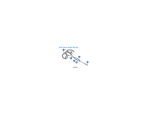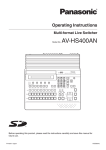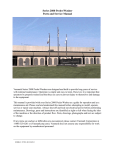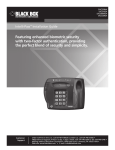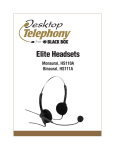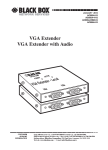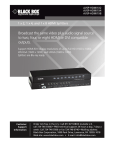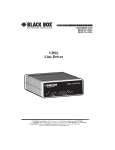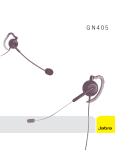Download HS400A Manual
Transcript
Pro-Fit Mobile Headset HS400A FCC INFORMATION FEDERAL COMMUNICATIONS COMMISSION AND INDUSTRY CANADA RADIO FREQUENCY INTERFERENCE STATEMENTS This equipment generates, uses, and can radiate radio frequency energy and if not installed and used properly, that is, in strict accordance with the manufacturer’s instructions, may cause interference to radio communication. It has been tested and found to comply with the limits for a Class A computing device in accordance with the specifications in Subpart J of Part 15 of FCC rules, which are designed to provide reasonable protection against such interference when the equipment is operated in a commercial environment. Operation of this equipment in a residential area is likely to cause interference, in which case the user at his own expense will be required to take whatever measures may be necessary to correct the interference. Changes or modifications not expressly approved by the party responsible for compliance could void the user’s authority to operate the equipment. This digital apparatus does not exceed the Class A limits for radio noise emission from digital apparatus set out in the Radio Interference Regulation of Industry Canada. Le présent appareil numérique n’émet pas de bruits radioélectriques dépassant les limites applicables aux appareils numériques de classe A prescrites dans le Règlement sur le brouillage radioélectrique publié par Industrie Canada. 1 PRO-FIT MOBILE HEADSET FCC REQUIREMENTS FOR TELEPHONE-LINE EQUIPMENT 1. The Federal Communications Commission (FCC) has established rules which permit this device to be directly connected to the telephone network with standardized jacks. This equipment should not be used on party lines or coin lines. 2. If this device is malfunctioning, it may also be causing harm to the telephone network; this device should be disconnected until the source of the problem can be determined and until the repair has been made. If this is not done, the telephone company may temporarily disconnect service. 3. If you have problems with your telephone equipment after installing this device, disconnect this device from the line to see if it is causing the problem. If it is, contact your supplier or an authorized agent. 4. The telephone company may make changes in its technical operations and procedures. If any such changes affect the compatibility or use of this device, the telephone company is required to give adequate notice of the changes. 5. If the telephone company requests information on what equipment is connected to their lines, inform them of: a. The telephone number that this unit is connected to. b. The ringer equivalence number. c. The USOC jack required: RJ-11C. d. The FCC registration number. 2 CDC STATEMENT Items (b) and (d) can be found on the unit’s FCC label. The ringer equivalence number (REN) is used to determine how many devices can be connected to your telephone line. In most areas, the sum of the RENs of all devices on any one line should not exceed five (5.0). If too many devices are attached, they may not ring properly. 6. In the event of an equipment malfunction, all repairs should be performed by your supplier or an authorized agent. It is the responsibility of users requiring service to report the need for service to the supplier or to an authorized agent. CERTIFICATION NOTICE FOR EQUIPMENT USED IN CANADA The Canadian Department of Communications label identifies certified equipment. This certification means that the equipment meets certain telecommunications-network protective, operation, and safety requirements. The Department does not guarantee the equipment will operate to the user’s satisfaction. Before installing this equipment, users should ensure that it is permissible to be connected to the facilities of the local telecommunications company. The equipment must also be installed using an acceptable method of connection. In some cases, the company’s inside wiring associated with a single-line individual service may be extended by means of a certified connector assembly (extension cord). The customer should be aware that compliance with the above conditions may not prevent degradation of service in some situations. Repairs to certified equipment should be made by an authorized Canadian maintenance facility—in this case, your supplier. Any repairs or alterations made by the user to this equipment, or equipment malfunctions, may give the telecommunications company cause to request the user to disconnect the equipment. Users should ensure for their own protection that the electrical ground connections of the power utility, telephone lines, and internal metallic water pipe system, if present, are connected together. This precaution may be particularly important in rural areas. 3 PRO-FIT MOBILE HEADSET CAUTION: Users should not attempt to make such connections themselves, but should contact the appropriate electric inspection authority, or electrician, as appropriate. The LOAD NUMBER (LN) assigned to each terminal device denotes the percentage of the total load to be connected to a telephone loop which is used by the device, to prevent overloading. The termination on a loop may consist of any combination of devices, subject only to the requirement that the total of the load numbers of all the devices does not exceed 100. NORMAS OFICIALES MEXICANAS (NOM) ELECTRICAL SAFETY STATEMENT INSTRUCCIONES DE SEGURIDAD 1. Todas las instrucciones de seguridad y operación deberán ser leídas antes de que el aparato eléctrico sea operado. 2. Las instrucciones de seguridad y operación deberán ser guardadas para referencia futura. 3. Todas las advertencias en el aparato eléctrico y en sus instrucciones de operación deben ser respetadas. 4. Todas las instrucciones de operación y uso deben ser seguidas. 5. El aparato eléctrico no deberá ser usado cerca del agua—por ejemplo, cerca de la tina de baño, lavabo, sótano mojado o cerca de una alberca, etc.. 6. El aparato eléctrico debe ser usado únicamente con carritos o pedestales que sean recomendados por el fabricante. 4 NOM STATEMENT 7. El aparato eléctrico debe ser montado a la pared o al techo sólo como sea recomendado por el fabricante. 8. Servicio—El usuario no debe intentar dar servicio al equipo eléctrico más allá a lo descrito en las instrucciones de operación. Todo otro servicio deberá ser referido a personal de servicio calificado. 9. El aparato eléctrico debe ser situado de tal manera que su posición no interfiera su uso. La colocación del aparato eléctrico sobre una cama, sofá, alfombra o superficie similar puede bloquea la ventilación, no se debe colocar en libreros o gabinetes que impidan el flujo de aire por los orificios de ventilación. 10. El equipo eléctrico deber ser situado fuera del alcance de fuentes de calor como radiadores, registros de calor, estufas u otros aparatos (incluyendo amplificadores) que producen calor. 11. El aparato eléctrico deberá ser connectado a una fuente de poder sólo del tipo descrito en el instructivo de operación, o como se indique en el aparato. 12. Precaución debe ser tomada de tal manera que la tierra fisica y la polarización del equipo no sea eliminada. 13. Los cables de la fuente de poder deben ser guiados de tal manera que no sean pisados ni pellizcados por objetos colocados sobre o contra ellos, poniendo particular atención a los contactos y receptáculos donde salen del aparato. 14. El equipo eléctrico debe ser limpiado únicamente de acuerdo a las recomendaciones del fabricante. 15. En caso de existir, una antena externa deberá ser localizada lejos de las lineas de energia. 16. El cable de corriente deberá ser desconectado del cuando el equipo no sea usado por un largo periodo de tiempo. 5 PRO-FIT MOBILE HEADSET 17. Cuidado debe ser tomado de tal manera que objectos liquidos no sean derramados sobre la cubierta u orificios de ventilación. 18. Servicio por personal calificado deberá ser provisto cuando: A: El cable de poder o el contacto ha sido dañado; u B: Objectos han caído o líquido ha sido derramado dentro del aparato; o C: El aparato ha sido expuesto a la lluvia; o D: El aparato parece no operar normalmente o muestra un cambio en su desempeño; o E: El aparato ha sido tirado o su cubierta ha sido dañada. 6 TRADEMARKS USED IN THIS MANUAL TRADEMARKS USED IN THIS MANUAL UL® is a registered trademark of Underwriters Laboratories Incorporated. Any other trademarks mentioned in this manual are acknowledged to be the property of the trademark owners. 7 PRO-FIT MOBILE HEADSET Contents 1. Specifications. . . . . . . . . . . . . . . . . . . . . . . . . . . . . . . . . . . . . . . . . . . . . . . . . . . . . . . . . . . . . . . . . . . 9 2. Introduction . . . . . . . . . . . . . . . . . . . . . . . . . . . . . . . . . . . . . . . . . . . . . . . . . . . . . . . . . . . . . . . . . . 10 2.1 About this Guide . . . . . . . . . . . . . . . . . . . . . . . . . . . . . . . . . . . . . . . . . . . . . . . . . . . . . . . . . . . . 10 2.2 Pro-Fit Mobile Components . . . . . . . . . . . . . . . . . . . . . . . . . . . . . . . . . . . . . . . . . . . . . . . . . . . 10 3. Pro-Fit Mobile Flexible Earhook . . . . . . . . . . . . . . . . . . . . . . . . . . . . . . . . . . . . . . . . . . . . . . . . . . 11 3.1 Wearing the Pro-Fit Mobile Flexible Earhook . . . . . . . . . . . . . . . . . . . . . . . . . . . . . . . . . . . . 11 3.2 Changing Ears . . . . . . . . . . . . . . . . . . . . . . . . . . . . . . . . . . . . . . . . . . . . . . . . . . . . . . . . . . . . . . 12 3.3 Removal . . . . . . . . . . . . . . . . . . . . . . . . . . . . . . . . . . . . . . . . . . . . . . . . . . . . . . . . . . . . . . . . . . . 12 3.4 Installation . . . . . . . . . . . . . . . . . . . . . . . . . . . . . . . . . . . . . . . . . . . . . . . . . . . . . . . . . . . . . . . . . 12 4. Earloop. . . . . . . . . . . . . . . . . . . . . . . . . . . . . . . . . . . . . . . . . . . . . . . . . . . . . . . . . . . . . . . . . . . . . . . 13 4.1 Installation . . . . . . . . . . . . . . . . . . . . . . . . . . . . . . . . . . . . . . . . . . . . . . . . . . . . . . . . . . . . . . . . . 13 4.2 Removal . . . . . . . . . . . . . . . . . . . . . . . . . . . . . . . . . . . . . . . . . . . . . . . . . . . . . . . . . . . . . . . . . . . 13 4.3 Changing Ears . . . . . . . . . . . . . . . . . . . . . . . . . . . . . . . . . . . . . . . . . . . . . . . . . . . . . . . . . . . . . . 14 4.4 Wearing the Earloop . . . . . . . . . . . . . . . . . . . . . . . . . . . . . . . . . . . . . . . . . . . . . . . . . . . . . . . . 14 5. Headband . . . . . . . . . . . . . . . . . . . . . . . . . . . . . . . . . . . . . . . . . . . . . . . . . . . . . . . . . . . . . . . . . . . . 15 5.1 Installation . . . . . . . . . . . . . . . . . . . . . . . . . . . . . . . . . . . . . . . . . . . . . . . . . . . . . . . . . . . . . . . . . 15 5.2 Removal . . . . . . . . . . . . . . . . . . . . . . . . . . . . . . . . . . . . . . . . . . . . . . . . . . . . . . . . . . . . . . . . . . . 15 5.3 Changing Ears . . . . . . . . . . . . . . . . . . . . . . . . . . . . . . . . . . . . . . . . . . . . . . . . . . . . . . . . . . . . . . 16 5.4 Wearing the Headband . . . . . . . . . . . . . . . . . . . . . . . . . . . . . . . . . . . . . . . . . . . . . . . . . . . . . . 16 6. Microphone Positioning. . . . . . . . . . . . . . . . . . . . . . . . . . . . . . . . . . . . . . . . . . . . . . . . . . . . . . . . . 17 7. Clothing Clip . . . . . . . . . . . . . . . . . . . . . . . . . . . . . . . . . . . . . . . . . . . . . . . . . . . . . . . . . . . . . . . . . . 18 8. Connecting to Your Telephone. . . . . . . . . . . . . . . . . . . . . . . . . . . . . . . . . . . . . . . . . . . . . . . . . . . 19 9. Maintenance . . . . . . . . . . . . . . . . . . . . . . . . . . . . . . . . . . . . . . . . . . . . . . . . . . . . . . . . . . . . . . . . . . 20 10. Troubleshooting . . . . . . . . . . . . . . . . . . . . . . . . . . . . . . . . . . . . . . . . . . . . . . . . . . . . . . . . . . . . . . 21 8 CHAPTER 1: Specifications 1. Specifications Transmit: Frequency Range—100 to 5000 Hz Microphone—Noise canceling electret Power—Current consumption: <0.2 mA; Operating voltage: 1.4 to 10 VDC Impedance—150 ohms Frequency Response—300 to 4000 Hz General: Compliance—Registered to UL® 1459; FCC Part 68 registered; OSHA Part 1910 subpart S; CSA C22.2 No. 225-M90 Weight—1.0 oz. (28.3 g) Sensitivity (@ 1 kHz w/2.2 Kohm load)— -39 dBV/Pa; Receive: Frequency Response—300 to 4000 Hz Input Impedance—150 ohms Speaker—Dynamic 9 PRO-FIT MOBILE HEADSET 2. Introduction 2.1 About This Guide This guide contains instructions for the Pro-Fit Mobile Headset. To derive maximum benefit from this versatile product, please take a few minutes to review this user guide. If after reviewing this guide you have any questions concerning the Pro-Fit Mobile Headset, please call Black Box Technical Support at 724-746-5500. 2.2 Pro-Fit Mobile Headset Components 7. 1. 2. 6. 4. 3. Over-the-head with a headband. Wearing styles can be easily changed by fitting the headset with appropriate snap-on/snap-off components. 10 XS 2. On-the-ear with choice of four earloop sizes. S 1. On-the-ear using a flexible earhook. M This Pro-Fit Mobile Headset package includes all the components for three wearing styles (see Figure 2-1): L 1. Flexible Earhook 3. 2. Clothing Clip 3. 2.5-mm Phono Plug 4. T-Hinge 5. Earloops (four sizes) 6. Receiver/Boom Assembly 7. Headband L M S Figure 2-1. Components. XS 5. CHAPTER 3: Flexible Earhook 3. Flexible Earhook To put on your new Pro-Fit Mobile earhook (see Figure 3-2): The Pro-Fit Mobile Headset comes out of the box with the flexible earhook installed (see Figure 3-1). The earhook is worn on the ear and can be reshaped for a comfortable and secure fit. Figure 3-1. Pro-Fit Mobile Earhook. 3.1 Wearing the Pro-Fit Mobile Flexible Earhook Use your fingers to grasp and reshape the gray area of the earhook. Black areas cannot be reshaped. The earhook retains its shape until reshaped. the uppermost part of your ear. 3. Adjust the flexible hook with your thumb until it rests comfortably along the back of the ear. 4. Lightly press the speaker against the ear for proper positioning. Figure 3-2. Wearing the Earhook. 1. Straighten out the earhook so that it points away from the speaker. 2. Swing the hook away from the speaker and slide the Pro-Fit Mobile earhook behind your ear until the saddle of the hook rests on To remove, simply lift the Pro-Fit Mobile off your ear. The earhook retains its custom contouring for the next time you put it on. Just slip it into place and gently snug up the flexible portion of the hook. Refer to the Microphone Positioning section (Chapter 6) for additional information. 3.2 Changing Ears Rotate the microphone boom 11 PRO-FIT MOBILE HEADSET 180° and swing the earhook around to the other side of the speaker (see Figure 3-3). the swivel stem notch over the mounting post on the receiver (see Figure 3-5). Figure 3-4. Removing Earhook. Figure 3-3. Changing Ears. 3.3 Removal 1. Position the receiver assembly with the speaker side up and the microphone boom at 12 o’clock (see Figure 3-4). 2. Place both your thumbs on the center of the receiver with your index fingers wrapped around the swivel stem and the cable strain relief. 3. Push your thumbs inward until the earhook pops free of the receiver. 3. With your fingers positioned behind the receiver, use your thumbs to push the earhook mounting ring until it snaps onto the receiver. CAUTION 3.4 Installation 1. Remove the earloop or headband. 2. Align the earhook mounting ring over the receiver with 12 Figure 3-5. Earhook Assembly. Do not force the microphone boom beyond the built-in stops! CHAPTER 4: Earloop 4. Earloop The Pro-Fit Mobile Headset can be fitted with a choice of earloop sizes. An earloop completely encircles the ear and positions the speaker directly over the ear canal. Four earloops are supplied, each marked as follows: X (Extra Small), S (Small), M (Medium) and L (Large). The size mark appears near the thinnest portion of the earloop. The earloop connects to the receiver using a T-hinge (see Figure 4-1). 4.1 Installation 1. Remove the earhook or headband. 2. Select the desired earloop size. 3. Snap the T-hinge onto the center portion of the earloop. 4. Hold the receiver firmly in one hand and press the stub end of the T-hinge with the other hand into the mounting post on the receiver until it snaps into place. M M 5. Pivot the earloop so that it encircles the receiver. 4.2 Removal Figure 4-1. Earloop Assembly. 1. Rotate the boom 90° (see Figure 4-2). Figure 4-2. Loop Disassembly. 2. Pivot the earloop away from the receiver and rotate the earloop so it is perpendicular to the receiver body. 3. Firmly grasp the earloop by placing your fingers through the ring. 4. While grasping the receiver housing, pull apart until the T-hinge pops free of the mounting post. 13 PRO-FIT MOBILE HEADSET 4.3 Changing Ears No adjustments are necessary. Simply turn the headset over to wear on the opposite ear. 4.4 Wearing the Earloop 1. Swing the earloop away from the receiver to form a “V” (see Figure 4-3). Figure 4-3. Earloop Wearing. 14 2. Position the back of the earloop behind the ear and gently pull forward until the speaker rests on the ear. Refer to the Microphone Positioning section (Chapter 6) for additional information. CHAPTER 5: Headband 5. Headband The Pro-Fit Mobile Headset can also be equipped with a fully adjustable, lightweight headband. 5.1 Installation Figure 5-2. Headband Removal. 1. Remove the earhook or earloop. 2. Align the mounting post on the receiver over the headband mounting ring (covered by a foam cushion). The mounting post fits into a notch on the headband mounting ring (see Figure 5-1). Figure 5-1. Headband Assembly. 3. Place your thumbs over the boom turret. 4. With your fingers behind the headband (on the foam cushion), use your thumbs to pop the headband onto the receiver. 5.2 Removal 1. Hold the headband with the foam cushion facing you (see Figure 5-2). 2. Position your fingers behind the outer portion of the headband mounting ring (covered by the foam cushion). 3. With your thumbs on the receiver, push outward until the headband pops free of the receiver. 5.3 Changing Ears To change from one ear to the other, rotate the microphone boom over the headband (see Figure 5-3). Do not force the microphone boom beyond the built-in stops! 15 PRO-FIT MOBILE HEADSET \ Figure 5-3. Changing Ears. 5.4 Wearing the Headband Position the headset lightly on your head (see Figure 5-4). The Stay-Put click-stop headband lengthens and shortens to the desired length for a custom fit (pull to lengthen, push to shorten). The headband retains its length and will not need adjusting each time it is put on. The stabilizer cushion rests just above the ear on the side of your head opposite the speaker. 16 Figure 5-4. Headband Wearning. Refer to the Microphone Positioning section (Chapter 6) for additional information. CHAPTER 6: Microphone Positioning 6. Microphone Positioning For the Pro-Fit Mobile Headset, the microphone boom should be adjusted so that the microphone is approximately one-half inch (12 mm) below and away from your lower lip (see Figure 6-1). noise and is better suited for noisy environments. Position the microphone properly to take advantage of the noise-canceling qualities of this microphone. Your Pro-Fit Mobile Headset has a flexible microphone boom: The flexible boom can be reshaped until the microphone is correctly positioned in front of your mouth. One hand should grasp and steady the receiver end of the boom. The other hand can then flex the boom (see Figure 6-2). Figure 6-2. Flex Boom Positioning. CAUTION Never forcefully rotate the microphone boom past its stop point in the receiver assembly! Figure 6-1. Positioning the Microphone. The Pro-Fit Mobile Headset is equipped with a noise-canceling microphone. This directional microphone rejects background 17 PRO-FIT MOBILE HEADSET 7. Clothing Clip The clothing clip should be fastened for comfortable wearing (see Figure 7-1). It is designed to prevent the weight of the cord from dislodging the headset. Figure 7-1. Clothing Clip. Position the clip conveniently on your clothing. To reduce excess slack, reposition the clip by sliding it up and down the cord. 18 CHAPTER 8: Connecting to Your Telephone 8. Connecting to Your Telephone For mobile applications, the headset is equipped with a 2.5 mm phono plug which connects directly into any mobile phone with this size port (see Figure 8-1). 1 Adapter not included 2 4 3 5 7 * 6 8 9 0 # 2.5 mm port Figure 8-2. Mobile Phone Connection Using an Optional Adapter. Call Black Box at 724-746-5500 for details. Figure 8-1. Mobile Phone Connection. For many mobile telephones without built-in headset ports, optional adapters are available (see Figure 8-2). 19 PRO-FIT MOBILE HEADSET 9. Maintenance The foam covers on the headband and microphone can be washed in mild soap and water. Replacement covers are available from Black Box. Call Technical Support at 724-746-5500 for details. Cautionary Notes to Computer Users When using any headset with a computer, take care in dry or lowhumidity environments to protect the user from electrostatic discharge from the monitor (CRT). Computer monitors can induce a substantial electrostatic charge when turned on or off, or when there is a power failure, and the resulting electrostatic discharge can be passed through the headset to ground. 20 A user in close proximity to or touching the computer may feel a common “shock” sensation, similar to touching a doorknob after walking across a carpet, causing no harm to the user. This discharge is entirely due to the computer monitor; the headset is merely the shortest path to ground. To minimize the possibility of electrostatic discharge through the headset, you can: • Use a grounded screen in front of the monitor. • Use static-dissipative wrist straps. • Increase the relative humidity in the room to 60% or more. • Install static-dissipative carpets or floor coverings (anti-static sprays can be helpful). • Remove the headset before turning the computer on or off. NOTE The Pro-Fit Mobile Headset meets all OSHA, UL, FCC, and CSA standards. CHAPTER 10: Troubleshooting 10. Troubleshooting 10.1 Calling Black Box If you determine that your Pro-Fit Mobile Headset is malfunctioning, do not attempt to alter or repair the unit. It contains no userserviceable parts. Contact Black Box at 724-746-5500. Before you do, make a record of the history of the problem. We will be able to provide more efficient and accurate assistance if you have a complete description, including: • the nature and duration of the problem. • when the problem occurs. • the components involved in the problem. • any particular application that, when used, appears to create the problem or make it worse. 10.2 Shipping and Packaging If you need to transport or ship your Pro-Fit Mobile Headset: • Package it carefully. We recommend that you use the original container. • If you are shipping the ProFit Mobile Headset for repair, make sure you include everything that came in the original package. Before you ship, contact Black Box to get a Return Materials Authorization (RMA) number. 21 CUSTOMER SUPPORT INFORMATION Order toll-free in the U.S.: Call 877-877-BBOX (outside U.S. call 724-746-5500) FREE technical support 24 hours a day, 7 days a week: Call 724-746-5500 or fax 724-746-0746 Mailing address: Black Box Corporation, 1000 Park Drive, Lawrence, PA 15055-1018 Web site: www.blackbox.com • E-mail: [email protected] 54-0218A June 2000 Printed in USA © Copyright 2000. Black Box Corporation. All rights reserved.























